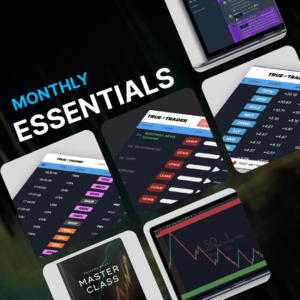Day Trading offers the rewards of independence, flexibility, and a competitive outlet. Like any venture, there is a learning curve involved. At the beginning of the journey is the prospect of determining what stocks are the best for day trading. There are many variables involved. Not only are there different answers for different traders, but a trader will also likely evolve their strategy and what they feel are the best stocks and strategies over time.
3 Characteristics of a Good Stock for Day Trading
It is important to remember that the best stocks from an investment standpoint are not necessarily the best stocks from a day trading perspective. Even within a day trading framework, different stocks may be better suited for different strategies and philosophies. When deciding which stocks to trade; liquidity, volatility, and even the company fundamentals are essential.
1. Volume and Liquidity
Perhaps the most critical trait to consider when choosing a stock to day trade is volume and liquidity. By nature, day trading involves getting in and out of positions on a timely basis. There is a wide discrepancy in how often various stocks trade throughout a day. Apple (AAPL) trades 51 million shares a day. Many successful NASDAQ stocks will exchange a few hundred thousand shares a day. As an example, Zynex (ZYXI) averages about 630,000 shares traded a day.
When a market begins to move, a day trader needs to act as quickly as possible. The less liquidity a stock has, the greater chance is that a trade will not be executed at a price the trader is looking to get, and may be forced to buy at a higher price (or sell lower).
Another aspect of liquidity is the spread. The spread is the difference between the bid and ask price (the bid is the price to sell a stock to a market maker, the ask is the price to buy from a market maker).
The wider the spread, the more a stock needs to move to make a profit. While the spread can be important in any trading strategy, this is particularly true for scalpers, those trying to make ten to twenty cents per share on a given trade.
The price of a stock can significantly affect its liquidity. If you are going to buy $100,000 of stock at $100 per share, you will have 1,000 shares. The same $100,000 transaction for $10 stock would purchase 10,000 shares.
The more liquidity a stock has, the less control key payers or market makers have in affecting the short-term price action, and a trader is less likely to get “head-faked” on a market move.
2. Volatility
The next most important characteristic is the volatility of a stock. To successfully trade, you need to find a stock that has some action. This can be determined by looking at the average daily range (ATR) as a percentage of the stock price. An average daily range can be determined as easily as downloading a stock’s historical pricing information from Yahoo Finance into a spreadsheet and comparing the daily range as a percentage of the closing price.
A trader might look at option pricing information and calculations of “implied volatility” for a stock. Implied volatility differs from historical volatility. Stocks are a living, breathing entity, and a change in implied volatility can give a trader a heads-up that historical volatility (and ranges) may no longer be relevant. Determining implied volatility may require the day trader to access options pricing and information platforms.
While a trader wants some volatility, they usually will not want too much. If a stock is “crazy” and unpredictable, it is tough to identify opportunities and manage risk. The best volatility for day trading is the goldilocks variety – not too much, not too little, but just the right amount.
3. Company Fundamentals
Surprisingly, a company’s fundamental outlook can be an important factor when choosing which stock to day trade. One of the advantages of day trading is that by not holding overnight positions, a trader can take on larger positions, knowing he will not take the risk of waking up in the morning to bad news for either the stock, or the market in general.
However, market-moving news does not always wait for the trading day to end. Individual stocks are often halted for trading only to re-open at a significant change in price. Trading halts are often implemented in event of anticipated news, as a response to order imbalances, as the result of a technical glitch, or for other regulatory concerns. Even when day trading, a trader should be aware of a company’s fundamental outlook and storylines that could put them on the wrong side of a trading halt.
What Patterns to Look for When Day Trading
Deciding on the characteristics and determining which patterns to look for present a bit of a “which comes first” dilemma. Once you have chosen which stocks to trade, you can start to identify what strategies and patterns to use. On the other hand, it is easier to determine which stocks you want to trade if you know what strategies and patterns to employ. A day trader should learn technical analysis to understand various chart patterns. While there are numerous patterns and set-ups to learn, they can generally be broken down into a couple of categories.
Break-outs
While everyone is familiar with the adage of buy low and sell high, sometimes buying high and selling higher is extremely profitable. Stocks that are approaching and breaking a new 52-week high can be good candidates for day trading. A trader should be cautious; however, those break-out situations also see a lot of head-fake and false break-outs. It is crucial to establish risk-reward parameters, and use stop-loss tools both on individual trades as well as a daily total.
When trading break-outs, there will be times a trade has been stopped out, only to reverse and make the move you were looking for while you sat on the sidelines. It is okay; there will always be another trade-provided you practice proper risk-management. There is no need to hit every break-out in order to be a successful day trader.
Leaning on Support and Reversals
Another popular pattern to look for is a reversal or even a slight move off of support. Good candidates for this type of trade can be stocks that are trading near 52-week highs but are currently on a pullback. There are long periods where markets and stocks don’t move a lot; this type of trade can help a trader make money during quiet periods.
These types of set-ups can also allow the daytrader to catch a reversal or a big rally from a low-risk entry point. While they don’t occur often, such windfall profits can sometimes make an entire week or month.
Tape-Watching
Not to be confused with technical analysis, tape-watching is the art of watching price and volume action in real-time.
When you start focusing on just two or three stocks, a funny thing will start to happen. You will get to know the personality of the stocks and how they trade relative to the market in general as well as other specific companies.
Does your stock tend to move before significant rallies in the market, or does it typically play catch up? How does the stock react to news, both good and bad? When you get to know how a stock typically trades, it becomes easier to identify opportunities when a stock is acting out of character.
Clues to watch for include volume, but more specifically, the size and speed of individual trades. This can be followed via time and sales indicators available on most trading platforms. When a stock has seen a strong rally, and large trades are taking place without price advancement, this may be a clue that the rally (at least for the short term) is about to slow or reverse.
Strategy and Risk-Management
A trader’s philosophy, strategy, and risk-management guidelines will help determine the best stocks for a particular day trader.
A scalper may look to take a tiny profit on a large number of short-term trades throughout the day, lasting no more than a minute or two. Such a strategy requires diligent risk-management, as no single wind-fall type trade will make up for any large losses. A risk-to-reward ratio for a scalper may be one to one, requiring a winning percentage over a large number of trades to be successful.
Another trader may take on a longer time frame (5-20 minutes) and look for a risk-reward ratio of 1 to 3. For example, a trader may buy Apple (AAPL) at 315, set a stop-loss at 314, and a target of 318. They are risking 1 dollar to make 3. Not including transaction costs (or other overhead), the trader will be break-even if they are right just 25% of the time.
A new day trader will have to spend some time going through the process of sorting out which strategies (and stocks) they are most comfortable engaging in.
Regardless of which philosophy you adopt, the most critical aspect will be risk-management. Risk-management should include stop-losses on individual trades, stop losses for the day, as well as week and month. Having the discipline to walk away when having a bad day can save a trader from going “on tilt” and losing several months of work within an hour or two. Even worse is the trader going on tilt and blowing out his entire account. It happens faster than most realize.
Finding Your Way
As true of many things in life, there is no single answer regarding the best strategy or best stock for day trading. What works best for you will depend on your personality, the time frame you would like to take, and your available capital. Are you more comfortable with direct chart patterns and technical analysis, or do you prefer to go with more of a feel from tape-watching?
The best thing a new or aspiring trader can do is start slow. Paper-trade, or trade minimal amounts with a simple goal to break even. The more you watch different market conditions and reactions, the more comfortable you will become identifying particular opportunities, and most importantly, the type of set-ups you are most comfortable trading.


